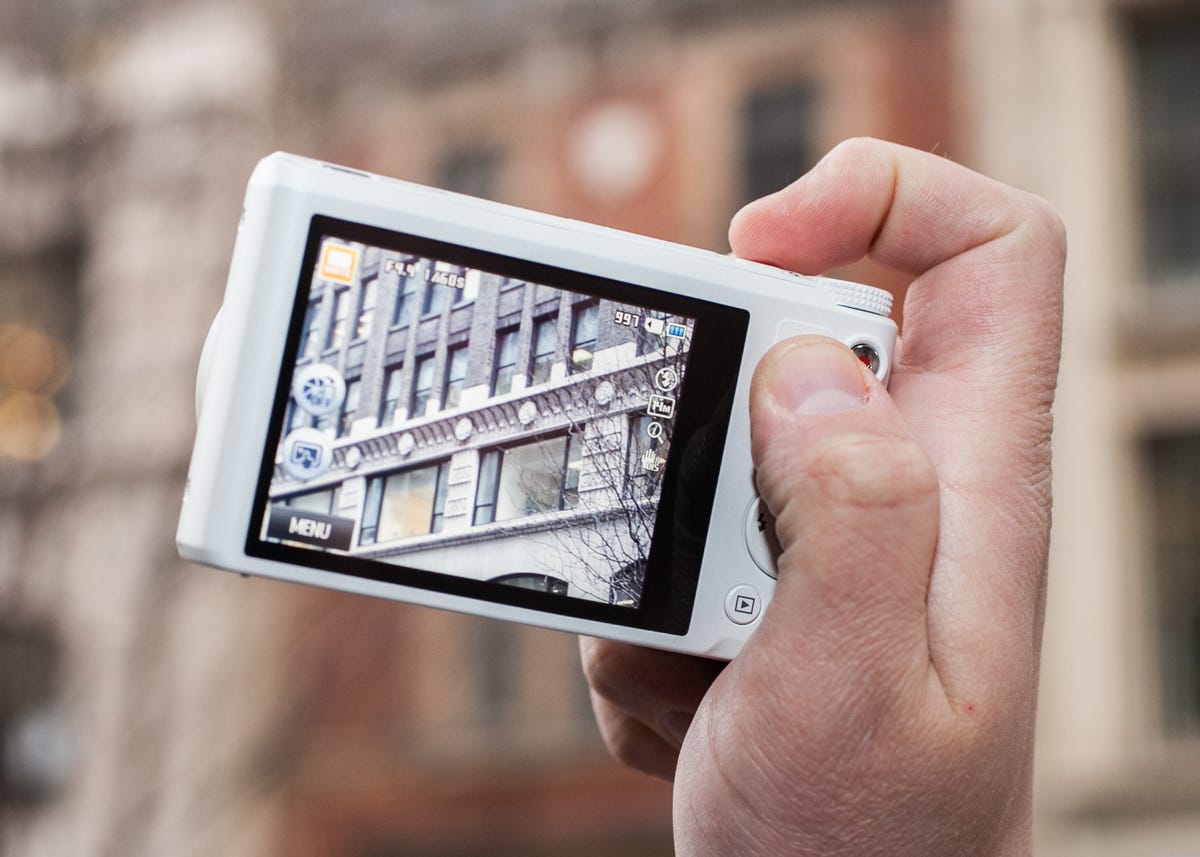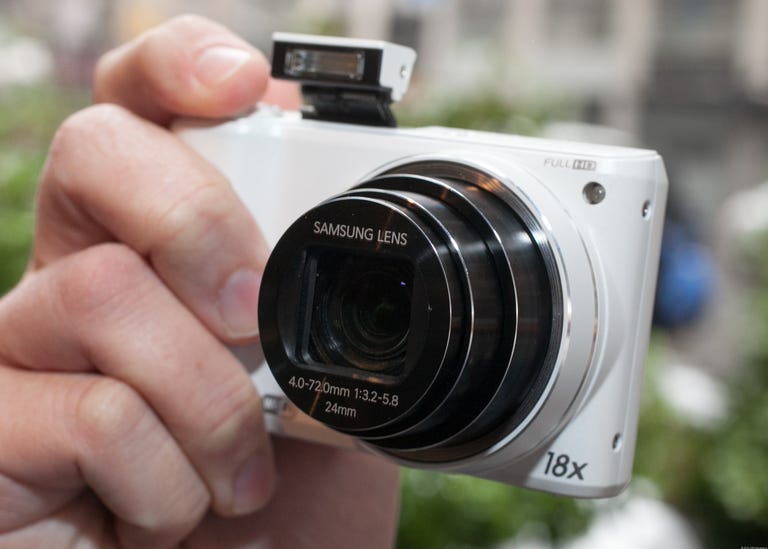 Why You Can Trust CNET
Why You Can Trust CNET Samsung WB250F Smart Camera review: An able smartphone camera companion
Thanks to well-implemented wireless features, good pricing, and decent performance, the WB250F is worth considering for social sharers.
Samsung is far out in front of its competition when it comes to Wi-Fi implementation in cameras, and it is models like the WB250F Smart Camera that prove it.
The Good
The Bad
The Bottom Line
For less than $250, you get a capable point-and-shoot camera with an 18x zoom lens and a 14-megapixel backside-illuminated (BSI) CMOS sensor. If you stopped there, it would be a pretty average camera. But once you add in all of its Wi-Fi capabilities -- from automatically sending photos to a smartphone while you're shooting to backing up to cloud storage or e-mailing photos straight from the camera -- and you've got something that can get you better photos and videos than a smartphone without sacrificing the easy sharing.
Now, its photo quality and shooting performance -- while very good for its class -- probably won't blow you away (it's still a midrange small-sensor camera, after all). But if you're in the market for a compact megazoom as a companion to your smartphone, keep reading.
Photo quality
For the WB250F, features come before photo quality. I'm not saying the photos are bad, just that if you're shopping by megapixels, you probably won't like the results when viewed at full size, limiting how much you'll be able to enlarge and crop. However, if your main concerns are getting better photos than a smartphone and a megazoom lens in a smallish body at a good price, then you're set with the WB250F.
Like many point-and-shoots with its price and features, the WB250F does well up to ISO 400, so you'll be able to get good-looking shots when you have plenty of light. Photos get noticeably softer from noise reduction at sensitivities above ISO 400; going above ISO 800 isn't recommended, as you lose too much detail and colors desaturate. That said, the built-in flash is actually useful since it can be angled up and bounced, getting you better results than you'd have without flash or with a blast of direct light that you'd get from other camera flashes. (For more information on this and other aspects of the WB250F's picture quality, see the slideshow above.)
Video quality is good, especially if your plans for it are just posting online or viewing at small sizes on a computer screen. There is some judder when panning the camera, and you'll see some ghosting with fast-moving subjects, but both are normal with compact cameras and not so distracting as to make video of sporting events unviewable. The zoom lens does work while recording, though the audio does mute slightly while it moves. The camera is relatively fast to refocus and adjust to exposure changes, too.

Shooting performance
Editors' note: We recently updated our testing methodology to provide slightly more real-world performance information, so the results aren't necessarily comparable with previous testing. Until we're finished refining our procedures, we will not be posting comparative performance charts.
The WB250F isn't lightning-fast, but it is one of the fastest for its price and features. From off to first shot takes 1.5 seconds, which is very good as is its shot-to-shot time of 1 second. Using the flash only increased the shot-to-shot time to 2 seconds. Shutter lag -- the time it takes from pressing the shutter release to capture without prefocusing -- is low, too, taking 0.3 second in bright lighting and 0.4 second in dim conditions. Keep in mind, though, this is with the lens at its widest position and focusing with the lens zoomed it takes slightly longer.
If you're trying to capture a burst of action, the camera's continuous mode is capable of capturing up to six photos at 8 frames per second (my lab tests clocked it at 7.6fps). However, focus and exposure are set with the first shot, so depending on how much subject movement there is, all of the shots may not be in focus.
Design and features
Samsung made some key changes to the design of the WB250F from its predecessor, the WB150F, most it for the better. For instance, Samsung used a touch screen this time around and made almost everything on the camera controllable by either it or the physical controls, so if you're already comfortable using a touch screen for taking photos or you like physical controls, you won't feel lost here. Plus, having the touch screen makes it much faster for inputting things like passwords for the camera's wireless features.
The WB150F's flash was poorly placed on the front of the camera, but that's been replaced by a handy pop-up flash that, as I noted earlier, can be pulled back and aimed up so you can bounce the flash; a feature few if any cameras have at this price point. However, you do have to press the flash button on top next to the mode dial to use it; it won't release on its own. (The button is also very close to the corner of the flash, so those with bigger fingers may keep it from popping up.)
| Key specs | Samsung WB250F |
|---|---|
| Price (MSRP) | $249.99 |
| Dimensions (WHD) | 4.2 inches by 2.4 inches by 1.3 inch |
| Weight (with battery and media) | 6.8 ounces |
| Megapixels, image sensor size, type | 14 megapixels, 1/2.3-inch backside-illuminated CMOS (16 megapixels total) |
| LCD size, resolution/viewfinder | 3-inch touch LCD, 460K dots/None |
| Lens (zoom, aperture, focal length) | 18x, f3.2-5.8, 24-432mm (35mm equivalent) |
| File format (still/video) | JPEG/H.264 AAC (.MP4) |
| Highest resolution size (still/video) | 4,320x3,240 pixels/ 1,920x1,080 at 30fps |
| Image stabilization type | Optical and digital |
| Battery type, CIPA rated life | Li ion rechargeable, 300 shots |
| Battery charged in camera | Yes; Micro-USB cable, wall adapter supplied |
| Storage media | SD/SDHC/SDXC |
Speaking of buttons, in order to put the flash on top, Samsung moved the power button to the middle of the camera on top. Though this might not seem like a big deal, it puts the power button out of reach of the shutter release. This basically kills the ability to quickly turn on the camera and fire off a shot.
Also, Samsung added a Direct Link button that lets you initiate a wireless feature with a single press. For example, I set it up to immediately open the e-mail feature so I could send off a photo quicker than jumping into the Wi-Fi menu (more on this menu in a second). It's a great idea, but the button is placed right where my left index finger sits when I pinch grip the camera, causing me to accidentally launch a search for a Wi-Fi signal.
One other oddity: Samsung placed spots for Wi-Fi and camera settings on the mode dial. Time after time, I'd go to connect to my smartphone and forget that I actually had to change out of my shooting mode in order to get to the Wi-Fi settings and instead, would hit the Menu button on back. This is something you would probably stop doing after a lot of use, but getting there might cause some frustration.
None of these are necessarily deal breakers, though, and really, having the pop-up flash is worth putting up with these things for me.
| General shooting options | Samsung WB250F |
|---|---|
| ISO sensitivity (full resolution) | Auto, 100, 200, 400, 800, 1600, 3200 |
| Photo Filter) | Auto, Daylight, Cloudy, Fluorescent H, Fluorescent L, Tungsten, Custom, Color Temp |
| Recording modes | Smart Auto, Program, Aperture Priority, Shutter Priority, Manual, Magic Plus (My Magic Frame, Split Shot, Motion Photo, Movie Filter, Photo Filter), Best Face, Smart (Beauty face, Continuous shot, Fireworks, Landscape, Low light shot, Panorama, Sunset, Macro, Action freeze, Light trace, Rich tone, Silhouette, Waterfall) |
| Focus modes | Center AF, Multi AF, Face Detection AF, Touch AF, Tracking AF, Manual Focus |
| Macro | 2 inches (Wide); 5.9 feet (Tele) |
| Metering modes | Multi, Spot, Center-weighted, Face Detection AE |
| Color effects | Custom RGB, multiple photo and movie filters |
| Burst mode shot limit (full resolution) | Six |
Shooting options are plentiful on the WB250F. If you like to experiment with control over shutter speeds and aperture, there are aperture- and shutter-speed-priority modes as well as full manual. Shutter speeds can be set from 16 seconds to 1/2000 second. Available apertures at the wide end include: f3.2, f3.6, f4.2, f4.6, f5.2, f5.8, f6.6, and f7.3; in telephoto you have just three: f5.8, f6.8, and f7.6.
Picking up from there is Samsung's Smart scene mode, which is loaded with automatic ways to do things like freeze action or create light trails without messing with shutter speeds on your own. Then there's Magic Plus mode with a large selection of filters and effects for both photos and videos and a new Motion Photo option for creating animated GIFs on the fly. Also included is Samsung's Best Face mode that lets you take a group shot -- firing off five frames -- and then you can pick the best faces for everyone in the shot, seamlessly combining them into one photo.
Wi-Fi
Samsung's Wi-Fi options remain some of the best available and easiest to use on point-and-shoot cameras. If you've ever thought, "why do I need Wi-Fi in my camera?" Samsung has got several answers to that question. It can be used to connect to your Wi-Fi network for automatic backups to a Windows computer or Microsoft SkyDrive, viewing photos and movie clips on DLNA-equipped devices, or sending them by e-mail; to connect to other Samsung Wi-Fi cameras for direct sharing between cameras; to connect to hot spots or wirelessly tether to a smartphone; and to connect to an Android 2.2-powered or higher smartphone or tablet or iOS 4.3 or higher device.
That last option can be used to upload content to sharing sites, but it will also allow you to control the camera remotely. Your display turns into a viewfinder and you can move the camera's zoom lens as well as hit the shutter release. It'll also use the device's GPS receiver to geotag your shots. And while doing all of these things previously required two apps, Samsung's combined them into one and added a new feature: AutoShare. Turning this feature on wirelessly pairs the camera with a phone or tablet and then every shot you take will be immediately sent from the camera to the device, ready for you to upload on the go or view on a larger screen.
Conclusion
Given its price and features, there's very little not to like about the Samsung WB250F Smart Camera. No, its photos are not digital SLR-quality, nor are they the quality of a large-sensor compact. This is still a midrange point-and-shoot when it comes to photo quality and shooting performance. For those looking to do more than simple snapshots with a phone without completely losing the fast sharing, this is a good way to go for less than $250.


